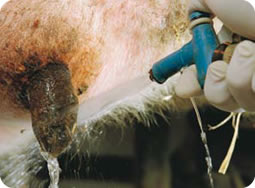
California Mastitis Test
The California Mastitis Test [CMT] is a cow side test to estimate the somatic cell count of milk.The test can be carried out by the milker in the parlour and it gives an immediate result. This result is not a numerical result but rather an indication as to whether the cell count is high or low. The CMT will only show changes in cell counts above 300,000.The advantage of the CMT over individual cow cell counts is that it assesses the level of infection of each quarter rather than an overall udder result.
The benefits of the CMT include
- Can be carried out by the milker
- Instant result
- Gives an indication of the level of infection of each quarter
- Inexpensive
The test is carried out in the following way
- Discard the foremilk
- Draw one or two squirts of milk from each quarter into the paddle dish
- Tip the paddle so that most of this milk is discarded
- Add an equal volume of reagent to the remaining milk
- Swirl the milk using a circular movement and examine for the presence of a gel or slime reaction
- Record your result by quarter
- Rinse out the paddle before testing the next cow
There are a number of ways to score the CMT, but dividing the results into four categories is probably the easiest. A negative result is seen when the milk remains watery. A score of 3, the highest, is when the solution almost solidifies.
| Score | Geling |
| Negative | None |
| 1 | Mild |
| 2 | Moderate |
| 3 | Heavy, almost solidifies |
Results for each animal should be recorded. If there is any doubt about the results of a test, then it can either be repeated immediately or at the next milking.
The CMT is very subjective and the results can vary depending on who is carrying out the test. It is important to make sure that the method is consistent. If too much or too little reagent is added, this will affect the outcome.
The CMT can be used in herds for the following
- Identification of high cell count cows and quarters
- Double checking individual cell count results
- Checking a cow which you suspect may have mastitis
- Checking the cell counts of quarters after mastitis treatment, and maybe discarding this milk until it returns to normal, i.e. looking for a negative result
- Identifying quarters for bacteriology sampling to identify the mastitis bacteria responsible for high cell counts in the herd

Farmers Guides
- Optimising the milking routine
- Basic mastitis types and control
- Probability of cure following intramammary antibiotic treatment
- Improving udder health around
drying off - Udder Examination
- California Mastitis Test
- Technique for infusion of a combination of dry cow antibiotic and OrbeSeal®
- Sterile milk sampling for bacteriology
- Collecting and transporting samples
- Risks of feeding dump milk to calves

